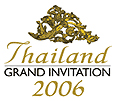|
 Thailand,
the land of smile, has world class dental care
that is as good as offered anywhere in the world
using dental clinics that are as nice or nicer
than you have at home. Most dentists and dental
specialists have been trained not only in Thailand
but also in the US or Europe Dental standards.
Nursing care is better from a patients perspective
than most countries including the US. Thailand,
the land of smile, has world class dental care
that is as good as offered anywhere in the world
using dental clinics that are as nice or nicer
than you have at home. Most dentists and dental
specialists have been trained not only in Thailand
but also in the US or Europe Dental standards.
Nursing care is better from a patients perspective
than most countries including the US.
Thailand is an interesting travel destination
and a travel bargain. Before or following your
procedures you can enjoy a wonderful vacation
in the city, on a island, at the beach or in the
mountains as Thailand offers all.
The kingdom of Thailand lies in the heart of
Southeast Asia, making it a natural gateway to
Indochina, Myanmar and Southern China. Its shape
and geography divide into four natural regions
: the mountains and forests of the North; the
vast rice fields of the Central Plains; the semi-arid
farm lands of the Northeast plateau; and the tropical
islands and long coastline of the peninsula South.
 The
country comprises 76 provinces that are further
divided into districts, sub-districts and villages.
Bangkok is the capital city and centre of political,
commercial, industrial and cultural activities.
It is also the seat of Thailand's revered Royal
Family, with His Majesty the King recognised as
Head of State, Head of the Armed Forces, Upholder
of the Buddhist religion and Upholder of all religions. The
country comprises 76 provinces that are further
divided into districts, sub-districts and villages.
Bangkok is the capital city and centre of political,
commercial, industrial and cultural activities.
It is also the seat of Thailand's revered Royal
Family, with His Majesty the King recognised as
Head of State, Head of the Armed Forces, Upholder
of the Buddhist religion and Upholder of all religions.
Thailand is a constitutional monarchy with His
Majesty King Bhumibol Adulyadej, or King Rama
IX, the ninth king of the Chakri Dynasty, the
present king. The King has reigned for more than
half a century, making him the longest reigning
Thai monarch. Thailand embraces a rich diversity
of cultures and traditions. With its proud history,
tropical climate and renowned hospitality, the
Kingdom is a never-ending source of fascination
and pleasure for international visitors.
Topography:
 Thailand
is divided into 4 natural regions: Thailand
is divided into 4 natural regions:
- The mountainous North, with its profusion
of multi-coloured orchids, fascinating native
handicrafts and winter temperatures are sufficiently
cool to permit cultivation of temperate fruits
such as strawberries and peaches;
- The high Northeast Plateau, which still jealously
guards its many archaeological and anthropological
mysteries;
- The Central Plain, one of the world's most
fertile rice and fruit-growing areas with colourful
traditional culture and way of life as well
as the sandy beaches of the East Coast and vibrant
cosmopolitan Bangkok;
- The peninsular South where the unspoiled beaches
and idyllic islands complement economically
vital tin mining, rubber cultivation and fishing.
Population:
Thais are well-known for their friendliness
and hospitality. A large majority of over 62 million
citizens of Thailand are ethic Thai, along with
strong communities whose ethnic origins lie in
China, India and elsewhere. About 7 million people
reside in the capital city of Bangkok.
People:
Thai (80%), Chinese (10%), Malay
(3%), and the rest are minorities (Mons, Khmers,
hill tribes) Ethnic Thais form the majority, though
the area has historically been a migratory crossroads,
and has thus produced a degree of ethnic diversity.
Integration is such, however, that culturally
and socially there is enormous unity.
 Language: Language:
Spoken and written Thai is largely
incomprehensible to the casual visitor. However,
English is widely understood, particularly in
Bangkok where it is almost the major commercial
language. English and some European Languages
are spoken in most hotels, shops and restaurants
in major tourist destinations, and Thai-English
road and street signs are found nationwide.
Religion: Buddhism (95%),
Muslim (4%), others (1%)
Government:

Thailand has had a constitutional monarchy since
1932. Parliament is composed of 2 houses, The House
of Representatives and the Senate. Both representatives
and senators are elected by the people. A prime
minister elected from among the representatives
leads the government. The country is divided into
76 provinces. The Bangkok Metropolitan Administration
comes under an elected governor. Appointed provincial
governors administer the other 75 provinces (Changwat),
which are divided into districts (Amphoe), sub-districts
(Tambon) and villages (Mu Ban).
|

